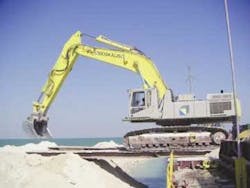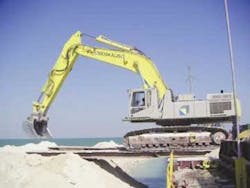Kashagan riser island taking shape above the rocks
A joint project team from Boskalis in the Netherlands and the Greek civil engineering contractor Archirodon is progressing well in its first season of work on the Kashagan field Riser Island (Complex D). Construction of an associated facility, Complex A, is also well advanced. The islands and their facilities have been designed to withstand one of the harshest offshore environments in the world.
Kashagan is Kazakhstan's first offshore development. This part of the North Caspian is extremely shallow (average depth: 3.3 m) and is subject to weather extremes: violent storms in summer and winter temperatures as low as -40°. There are also significant fluctuations in water level and heavy drift ice during the winter months. Ice build-up is exacerbated through the combination of shallow water, low salinity, and low temperatures. The North Caspian is also an area of extreme environmental sensitivity. The Volga and Ural deltas flowing into the North Caspian are the sturgeon's main breeding grounds.
Offshore Kazakhstan International Oper-ating Co. (OKIOC), on behalf of a consortium of multi-national oil companies, invested heavily in exploratory drilling at two locations, Kashagan East and Kashagan West. Boskalis, a pioneer in the construction of artificial islands for oil and gas exploration and production, was involved in the construction of the foundation berms for Sunkar, the converted drilling barge used for the Kashagan exploration program during 1998-2001. This led to major oil discoveries at Kashagan East and Kashagan West.
Phase 1 of Kashagan's development is costing around $10 billion, with an anticipated recovery of 5.2 Bbbl, while subsequent phases offer the potential to increase recovery to 13 Bbbl. First oil is expected in 2008, with initial production at 75,000 b/d, gradually building to 450,000 b/d. Future development phases could more than double production rates.
null
Kashagan riser island
Agip KCO awarded a $155 million contract for construction of elements of the Kashagan production facilities to the Boskalis/Arch-irodon joint venture in early 2003. (Boskalis also has a 45% stake in Archirodon). The contract involves building a complex of rock islands in 4-m water depth at a location some 75 mi offshore. Almost 4 million tonnes of rock will be required for the construction of the island group and its ice barriers.
The D Block Island complex will have an area of more than 100,000 sq m, of which the Riser Island, currently under construction, will be 37,000 sq m. For the most part, this Riser Island will have an elevation of +3 m CD. At the eastern side, an area of some 1,800 sq m is being raised to +7 m CD, to pre-consolidate subsoil prior to riser installation.
The scope of work includes the construction of four outer main ice barriers, three inner ice barriers, the Riser Island (including flare extension) and three pipe rack cofferdams. The cofferdams, with a total length of 715 m, each consist of two sheet pile walls, between which quarry run is being placed. The width between the sheet piles is 20 m. The top level of the fill is specified at +5.2 m CD.
Construction of the Riser Island began in April, and involves some 800,000 tonnes of limestone (specific density: 1.89 tonnes/cu m). Five types of rock are required for the Riser Island, cofferdams and ice barriers: high density (300-1,000 kg), high density (60-300 kg), high density (100-300 cm), limestone (20-500 kg) and limestone quarry run.
Boskalis Area Manager Constans Koot-stra says: "Rock is transported to site by barges operating from a load-out quay 250 km to the south, at a location close to an operations base at the fishing port of Bautino. Most of the rock is sourced nearby, from the Atash limestone quarry. A fleet of 16 flattop barges and seven tugs, together with spreader barges, is employed in the supply of limestone to the construction site. A large excavator, mounted on a spreader barge, is used to discharge the transport barges and place rock as required. There are also two accommodation barges, stationed to allow work to proceed efficiently at various site locations."
By late-May, sufficient rock had been placed to raise the level of the Riser Island above the surface. The project team then "went ashore" with heavy plant to continue the construction program and, eventually, to establish the island's final contours. Towards the end of July, the first shipment of 1,700 m of sheet piling was scheduled to arrive on site, allowing sheet piling of the island's cofferdams to commence.
Outstanding works include the finishing of the Riser Island's surface, consisting of a geotextile layer covered with rock, which will then be compacted. In some areas, the surface will consist of pre-cast concrete elements. The outer perimeter of this artificial island will be sloped and protected by a 1.5-m thick layer of armor rock (20-500 kg gradation), to resist the winter drift ice. The project team also expects to transport and place 30,000 tonnes of hard rock (specific density: 2.7 tonnes/cu m) for the outer armor layer.
"Work on site has a weather window of April to mid-November," Kostra adds. "All vessels and equipment will demobilize and return to Bautino base in early November." The 2005 campaign will likely include work on the main ice barriers, which will have crest heights ranging from +4.2 m CD to +6.2 m CD and crest widths ranging from 5 m to 10 m. The outer armor will mainly consist of 300-1,000 kg high-density rock. Meanwhile, temporary embankments have been constructed to protect the island until construction resumes next year.

